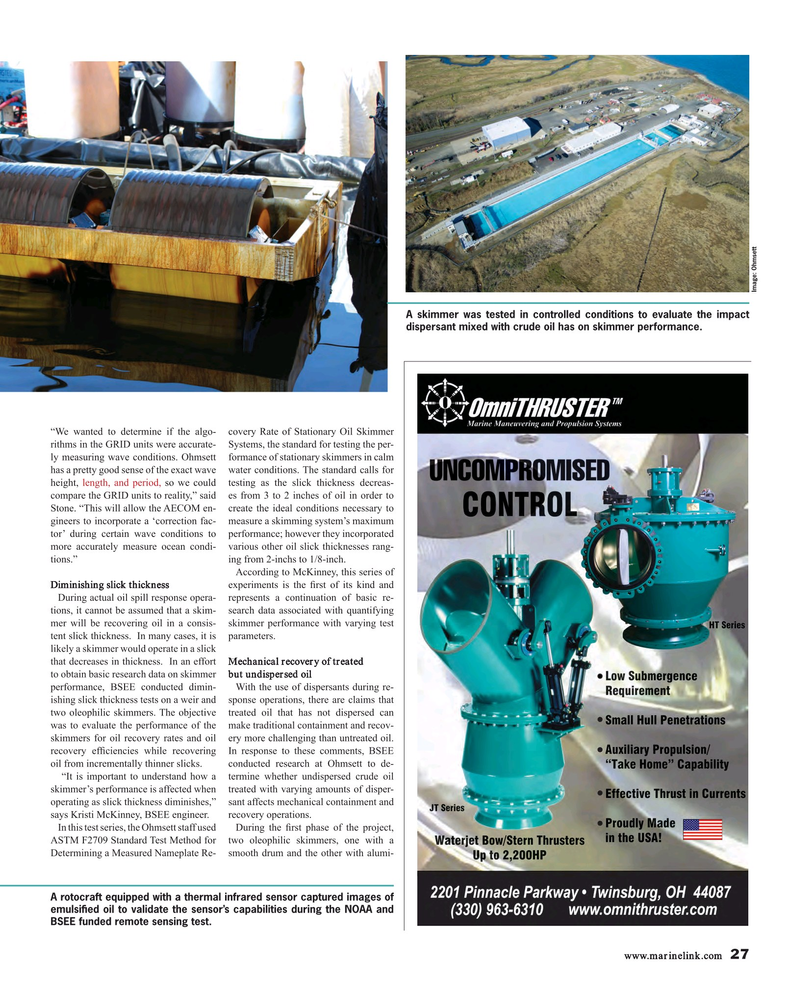
Page 27: of Maritime Reporter Magazine (July 2018)
Marine Communications Edition
Read this page in Pdf, Flash or Html5 edition of July 2018 Maritime Reporter Magazine
Image: Ohmsett
A skimmer was tested in controlled conditions to evaluate the impact dispersant mixed with crude oil has on skimmer performance.
“We wanted to determine if the algo- covery Rate of Stationary Oil Skimmer rithms in the GRID units were accurate- Systems, the standard for testing the per- ly measuring wave conditions. Ohmsett formance of stationary skimmers in calm has a pretty good sense of the exact wave water conditions. The standard calls for height, length, and period, so we could testing as the slick thickness decreas- compare the GRID units to reality,” said es from 3 to 2 inches of oil in order to
Stone. “This will allow the AECOM en- create the ideal conditions necessary to gineers to incorporate a ‘correction fac- measure a skimming system’s maximum tor’ during certain wave conditions to performance; however they incorporated more accurately measure ocean condi- various other oil slick thicknesses rang- tions.” ing from 2-inchs to 1/8-inch.
According to McKinney, this series of
Diminishing slick thickness experiments is the ? rst of its kind and
During actual oil spill response opera- represents a continuation of basic re- tions, it cannot be assumed that a skim- search data associated with quantifying mer will be recovering oil in a consis- skimmer performance with varying test tent slick thickness. In many cases, it is parameters.
likely a skimmer would operate in a slick that decreases in thickness. In an effort Mechanical recovery of treated to obtain basic research data on skimmer but undispersed oil performance, BSEE conducted dimin- With the use of dispersants during re- ishing slick thickness tests on a weir and sponse operations, there are claims that two oleophilic skimmers. The objective treated oil that has not dispersed can was to evaluate the performance of the make traditional containment and recov- skimmers for oil recovery rates and oil ery more challenging than untreated oil. recovery ef? ciencies while recovering In response to these comments, BSEE oil from incrementally thinner slicks. conducted research at Ohmsett to de- “It is important to understand how a termine whether undispersed crude oil skimmer’s performance is affected when treated with varying amounts of disper- operating as slick thickness diminishes,” sant affects mechanical containment and says Kristi McKinney, BSEE engineer. recovery operations.
In this test series, the Ohmsett staff used During the ? rst phase of the project,
ASTM F2709 Standard Test Method for two oleophilic skimmers, one with a
Determining a Measured Nameplate Re- smooth drum and the other with alumi-
A rotocraft equipped with a thermal infrared sensor captured images of emulsi? ed oil to validate the sensor’s capabilities during the NOAA and
BSEE funded remote sensing test.
www.marinelink.com 27
MR #7 (26-33).indd 27 MR #7 (26-33).indd 27 7/5/2018 3:35:01 PM7/5/2018 3:35:01 PM

 26
26

 28
28
